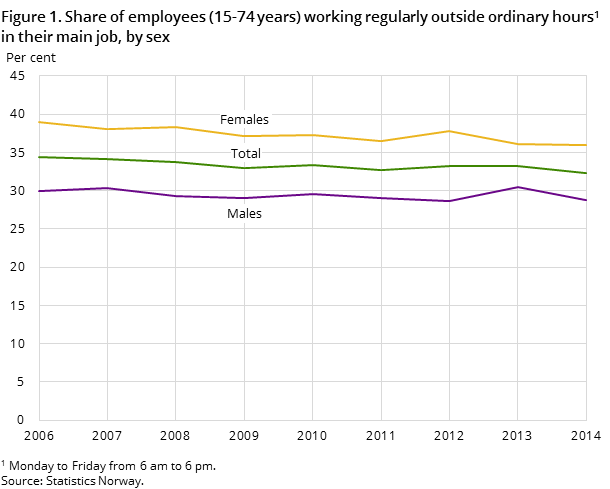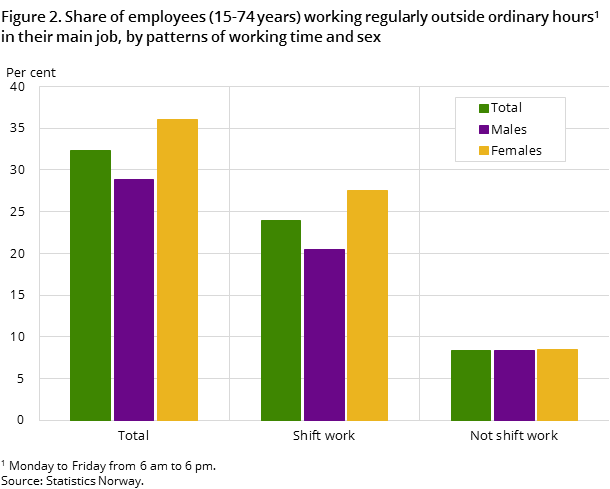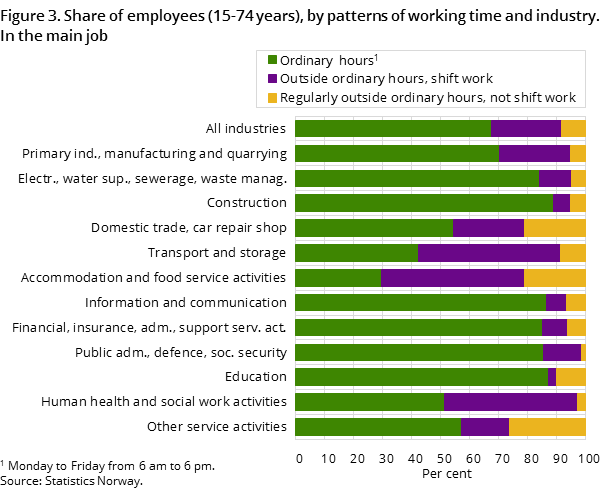Content
Published:
This is an archived release.
Less work outside ordinary hours
A total of 789 000 employees worked outside of ordinary hours in 2014, corresponding to 32 per cent of the employees in total. This share has decreased gradually over the last eight years, from 34 per cent in 2006.
| 2011 | 2012 | 2013 | 2014 | |
|---|---|---|---|---|
| 1Regularly work outside Monday to Friday from 6 am to 6 pm. | ||||
| Both sexes | ||||
| Employees, total | 100.0 | 100.0 | 100.0 | 100.0 |
| Ordinary hours | 67.3 | 66.8 | 66.8 | 67.7 |
| Outside ordinary hours1 | 32.7 | 33.2 | 33.2 | 32.3 |
| Males | ||||
| Employees, total | 100.0 | 100.0 | 100.0 | 100.0 |
| Ordinary hours | 71.0 | 71.3 | 69.5 | 71.2 |
| Outside ordinary hours1 | 29.0 | 28.7 | 30.5 | 28.8 |
| Females | ||||
| Employees, total | 100.0 | 100.0 | 100.0 | 100.0 |
| Ordinary hours | 63.5 | 62.2 | 63.9 | 64.0 |
| Outside ordinary hours1 | 36.5 | 37.8 | 36.1 | 36.0 |



The decrease in the share of employees working outside ordinary hours in their main job has been strongest among women. From 2006 to 2014, the share with this kind of work among female employees has decreased from 39 to 36 per cent. The corresponding share among men has remained relatively stable at around 30 per cent during these years – and in 2014, the share was 29 per cent. The gender difference with regard to work outside ordinary hours is related to the fact that this kind of work is widespread in human health and social service activities – where women are highly overrepresented.
Almost half of the women in human health and social service
Of the 428 000 female employees who worked outside ordinary hours in 2014, 209 000 worked in human health and social services activities. A total of 49 per cent of the employees in this industry had this kind of work. Work outside ordinary hours is almost as widespread among men as among women in this industry – but, as mentioned above, the great majority of the employees are women. Many of the male employees working outside ordinary hours do so within manufacturing, quarrying or primary industries. In 2014, 23 per cent of the men with this kind of work were employed in these industries – 83 000 in total. Other industries with high shares of employees working outside ordinary hours include accommodation and food service activities, transport and storage and domestic trade.
One out of ten works on Sundays
In 2014, 10 per cent of employees worked regularly on Sundays in their main job. Regularly Sunday work is defined as working at least two Sundays during a period of four weeks, according to the work contract. Other employees also have to work on Sundays according to their work contract, but less frequently. If we include this group, every fourth employee worked on Sundays in 2014 – either regularly or once in a while. This share has remained stable at around 25-26 per cent during the last eight years. Similarly, every third employee worked Saturdays either regularly or once in a while in 2014.
Often combined with part-time employment
Since the share working outside ordinary hours is high in some industries where part-time work is widespread, the total share of employees working outside ordinary hours is high among part-time employees. While the share of full-time employees working outside ordinary hours was 27 per cent in 2014, the corresponding share among part-time employees was 49 per cent. Both of these groups have relatively small disparities between women and men with regard to the frequency of working outside ordinary hours.
The statistics is published with Labour force survey.
Contact
-
Statistics Norway's Information Centre
E-mail: informasjon@ssb.no
tel.: (+47) 21 09 46 42
